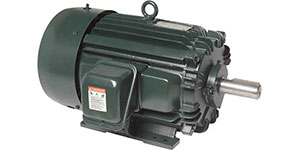How Do Motors Fail? (Insulation)
 The proper application and selection of low voltage motors can be a demanding task.
The proper application and selection of low voltage motors can be a demanding task.
A good starting point would be to consider why motors fail in the first place. In this issue, Toshiba will investigate some of the reasons why motors fail. If you talk to your local rewind shop, you would most likely find that they also experience very similar, if not identical, reasons described in this issue.
Insulation Failures (30 to 40%)
- Overload
- Excessive Number of Starts
- Contaminants/Ventilation Failure
- Thermal Aging
- Voltage Spikes from ASDs
- System Disturbances
- Excessive Load Inertia
- Insufficient Torque
- Locked Rotor
- Single Phasing
- High Ambient
- Vibration
The number one cause of an insulation failure is due to overload conditions, not just from a lack of proper protection, but also due to abuse. Furthermore, as is the case in bearing failures, many of the insulation failures are a result of the insulation exceeding its temperature limits in one form or another, indicating that a motor design with a large thermal margin is very valuable.
Thermal Margin is the difference between actual design temperature rise of the motor at 1.0 SF under load, and the rated maximum allowable temperature (in most cases, which would be 155°C, the limit for a Class F rated insulation system). Temperature rise will be discussed in later issues in greater detail. Insulation failures that are affected by temperature in one way or another include: Overload, Excessive Number of Starts, Contaminants/Ventilation Failure, Thermal Aging, System Disturbances, Excessive Load Inertia, Insufficient Torque, Locked Rotor, Single Phasing, and High Ambient.
When evaluating motor insulation systems, the following important considerations should be made:
- Temperature Rise: The cooler the motor's operating temperature, the longer the expected life of the motor will be. For every 10°C cooler, the life of your insulation doubles.
- Torque: The more torque a motor has, the faster the acceleration time, which results in less heating of the motor. taccel = [wk2 x Speed Change] / [308 x Avg Accelerating Torque].
- Class of Insulation: Most motors sold meet Class F insulation ratings; however a motor that is constructed with Class H materials will have a longer thermal life.
- Solid Bracing of End Turns / Cuffed Slot Liners / # of Dip & Bakes / Proper Phase Separation: Heat shrink lacing material helps to ensure the solid bracing of end turns. Lack of proper support of the insulation system can cause vibrations between turns, phases, and ground at startup and when exposed to PWM waveforms. The more dip and bakes, the more secure and solid the insulation system becomes. Proper phase paper placement is very important to ensure complete separation of phases, minimizing opportunities for failures.
- Length of Stator & Rotor Cores: Overall weight of the motor might be a good indication of core length in a properly designed motor. Long cores not only indicate a motor with good efficiencies and torque capability, but also give the motor mass to absorb heat.
- Slot Fill: A tight slot fill ensures maximum copper volume for reducing resistance losses in the stator, but also allows for proper heat conduction to the motor frame and prevents potentially damaging vibrations between turns and ground.
- Efficiency Design Features: Tooth density, thickness of laminations, size of end rings, width of the air gap, and fan size are all factors which can increase and/or decrease efficiency. More efficient motors run cooler. A well-designed motor is one with very high efficiencies, very high torques, and very large thermal margin.
- Inverter Duty Wire: Dielectric strength of insulation system rated to handle voltage spikes as per NEMA MG1, Part 31, Vpeak = 3.11 x VRMS, with a ≥0.1 µs rise time.

